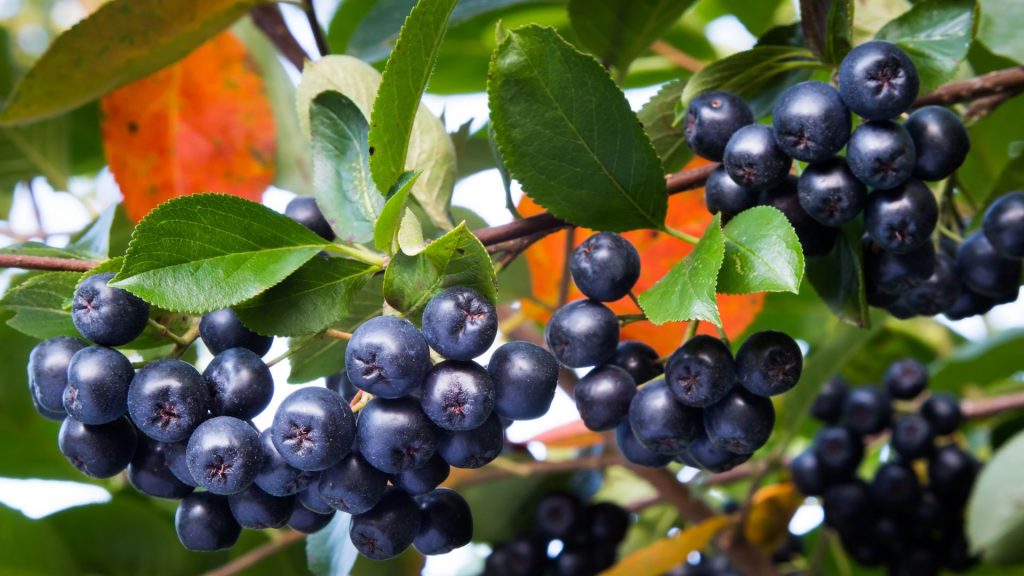Unlocking the Potential of a Remarkable Fruit
Nestled among the picturesque rolling hills of southwestern Wisconsin, just outside Blanchardville, lies Barham Gardens. Kim and Roberta Barham live on this small homestead farm where they tend around 1,000 aronia berry plants. At first glance, these unassuming shrubs could easily go unnoticed by the casual observer. But their value and potential are slowly gaining recognition.

Aronia berries, also known as black chokeberries, are a small fruit with an extraordinary range of benefits. When it comes to functional foods, aronia berries top the charts.
These little berries are bursting with phytonutrients, tannins, and minerals—a powerhouse of antioxidants. Aronia berries have the highest Oxygen Radical Absorbance Capacity (ORAC) of any fruit yet studied, surpassing trendy “superfoods” like goji berries, pomegranates, and cranberries. The scientific literature is rich. Studies have linked aronia berries to cardiac and cancer protection, immune support, blood pressure regulation, and many other advantages.
The medicinal value of this native fruit was no secret to indigenous peoples in Wisconsin. Aronia berries have been used for centuries by the Potawatomi people to treat various ailments. Today, aronia berries are a growing favorite among health-conscious consumers. Often sold frozen, aronia are commonly used in juices, jams, and wines. They also have lots of potential for use in baked items.
While there are some growers in Wisconsin producing more than the 3,000-pound maximum crop that the Barhams harvest in the fall, most commercially available aronia berries come from Eastern Europe. “It’s cheaper to buy from Poland than it is to buy domestically,” said Kim Barham, referencing the subsidies that help Poland hold the title of largest producer. At least 80% of global aronia berry production comes from Poland, but the low-maintenance crop represents an environmental and economic opportunity for Wisconsin to champion our native species of superfood.
the Barhams harvest in the fall, most commercially available aronia berries come from Eastern Europe. “It’s cheaper to buy from Poland than it is to buy domestically,” said Kim Barham, referencing the subsidies that help Poland hold the title of largest producer. At least 80% of global aronia berry production comes from Poland, but the low-maintenance crop represents an environmental and economic opportunity for Wisconsin to champion our native species of superfood.
 At Barham Gardens, the original shrubs planted by Kim and Roberta Barham in 2009 continue to yield abundant berries. Like all perennials, aronia plants promote soil health. They come back year after year without requiring annual soil disturbance, aggressive fertilizers, or pesticides. They also provide important pollinator habitat at a critical time in the growing season, given the plant’s early flowering period.
At Barham Gardens, the original shrubs planted by Kim and Roberta Barham in 2009 continue to yield abundant berries. Like all perennials, aronia plants promote soil health. They come back year after year without requiring annual soil disturbance, aggressive fertilizers, or pesticides. They also provide important pollinator habitat at a critical time in the growing season, given the plant’s early flowering period.
Dale and Cindy Secher, owners of Carandale Farm, began a trial planting of uncommon fruit in 2003. Aronia was chosen as the initial uncommon fruit due to its social, environmental, and economic potential. This trial was partially funded by a grant from the WI Department of Agriculture, Trade and Consumer Protection (DATCP) aimed at promoting agricultural development and diversification. The University of Wisconsin-Madison Center for Integrated Agricultural Systems (CIAS) established and hosted a website (uncommonfruit.cias.wisc.edu) dedicated to providing information about aronia and other lesser-known fruits. Other uncommon fruits have since been incorporated into the repertoire of crops cultivated and sold by Carandale Farm.
According to Secher, the crop is grower-friendly, cold hardy, tolerant of most soil types, and naturally resistant to drought, insects, and disease. These factors should allow farmers of commodity crops to make productive use of marginal land by growing aronia berries. There is “exciting potential to generate an alternative cash flow with minimal risk and very little additional investment,” said Secher. In addition to being a good companion crop for growers and backyard hobbyists, Aronia could also be grown and marketed as a standalone nutraceutical crop because, being similar to blueberries, infrastructure for harvesting and processing already exists on a commercial scale.
So why aren’t more operations like Barham Gardens popping up across Wisconsin? It turns out that the supply of aronia berries in the state is greater than the demand. “We have thousands of pounds of aronia berries sitting in freezers across Wisconsin,” said Kim Barham. Despite a growing group of dedicated admirers, most Wisconsinites are unfamiliar with the berry. Roberta Barham, a former president of the Midwest Aronia Association, says “people don’t know what it is, we need education on the health benefits, and how to cook with it.”
While the American Aronia Berry Association serves as an educational resource, it doesn’t have the same marketing resources as organizations like the Cranberry Marketing Committee. Wisconsin has several companies, connected to the cranberry industry, that can process aronia berries and create value-added products that may be more popular with consumers.
“This infrastructure is advantageous,” said Roberta Barham, “[but] I have found that growers need to reach out and advocate for themselves… It would be advantageous for groups to unite cooperatively towards increasing Aronia awareness and developing commercial products.” Roberta Barham was emphatic on the importance of collaboration among aronia berry growers in Wisconsin. By working together to harvest, clean, and distribute aronia berries, growers in Wisconsin have increased retail locations and sales of value-added aronia products.
Secher shares this perspective, saying “new products made from the aronia berry could provide a nucleus for local and regional infrastructure that would benefit other locally produced food items.” The vision Secher has is a bottom-up approach where producers are strategic partners and control brand identity. “I believe that in this country, we have a unique opportunity to get it right with a new product stream where raw product availability, processing capacity and consumer demand grow simultaneously.”
Barham Gardens has found success selling fresh berries at the Dane County Farmers Market and partnering with local grocery stores. Other farmers, like those at Bellbrook Berry Farm, have capitalized on the slowly growing market demand by offering frozen aronia berries and concentrated aronia juice. The future of this remarkable berry is now in the hands of Wisconsin consumers. Choose wisely.

